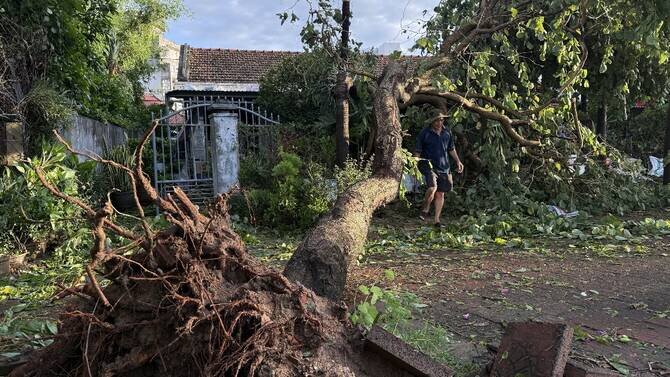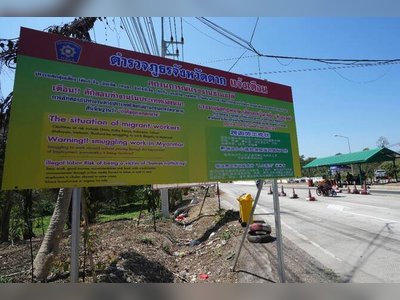
Typhoon Kalmaegi Kills Five in Vietnam as Philippines Prepares for New Storm
Fierce winds and torrential rains from Typhoon Kalmaegi cause damage and casualties in Vietnam, while the Philippines readies itself for another potentially powerful storm.
DAK LAK: Typhoon Kalmaegi brought fierce winds and torrential rains to Vietnam on Friday, resulting in at least five fatalities and widespread damage across the country's central provinces.
This incident follows the storm's impact on the Philippines earlier in the week, where it left scores dead or missing.
As floodwaters receded in affected areas of Vietnam, recovery efforts commenced.
Local authorities and residents were seen clearing debris, repairing roofs, and rebuilding damaged homes, with over 1.6 million households experiencing power outages.
In total, 52 houses collapsed, while nearly 2,600 others sustained damage, particularly in Gia Lai province.
In the Philippines, President Ferdinand Marcos Jr. declared a state of national emergency as the country braced for Typhoon Fung-wong (locally known as Uwan), which could affect densely populated regions including Manila.
The storm was forecast to expand to approximately 1,400 kilometers in diameter before making landfall.
The Office of Civil Defense reported at least 188 deaths and 135 missing individuals in the Philippines due to Kalmaegi.
Over half a million people were displaced, with nearly 450,000 evacuated to shelters.
As of Thursday, over 318,000 remained in these shelters.
In Vietnam, numerous areas experienced uprooted trees, damaged power lines, and flattened buildings as Kalmaegi weakened into a tropical storm and moved into Cambodia on Friday.
Factories in Binh Dinh province suffered significant damage to their roofs and equipment due to flooding, while residents in Quy Nhon reported finding scattered household items and corrugated metal roofs after the storm.
As the skies cleared on Friday morning, residents assessed the damage left behind by Kalmaegi.
Streets were littered with fallen branches and twisted sheets of metal, with muddy water still present in low-lying areas where rivers had surged to record heights overnight.
Shopkeepers dried out waterlogged goods, while families cleaned mud from their doorsteps and repaired missing roof tiles.
Kalmaegi struck Vietnam as the central region was already recovering from floods caused by heavy rainfall.
Authorities evacuated more than 537,000 people, many by boat, due to rising floodwaters and the risk of landslides.
The storm was expected to dump up to 24 inches (600 millimeters) of rain in some areas before moving into Laos and northeast Thailand.
Three fishermen were reported missing on Thursday after their boat was swept away by strong waves near Ly Son Island off Quang Ngai province, with search efforts suspended due to worsening weather conditions.
The Philippines experiences around 20 typhoons and storms annually and is one of the world's most disaster-prone countries.
Vietnam, hit by approximately a dozen storms each year, has faced an unusually relentless series this year.
Typhoon Ragasa in late September was followed by Typhoon Bualoi and Typhoon Matmo, which together left more than 85 people dead or missing and caused estimated damages exceeding $1.36 billion.
Scientists warn that climate change is exacerbating storms and rainfall across Southeast Asia, leading to increasingly destructive and frequent floods and typhoons.
This incident follows the storm's impact on the Philippines earlier in the week, where it left scores dead or missing.
As floodwaters receded in affected areas of Vietnam, recovery efforts commenced.
Local authorities and residents were seen clearing debris, repairing roofs, and rebuilding damaged homes, with over 1.6 million households experiencing power outages.
In total, 52 houses collapsed, while nearly 2,600 others sustained damage, particularly in Gia Lai province.
In the Philippines, President Ferdinand Marcos Jr. declared a state of national emergency as the country braced for Typhoon Fung-wong (locally known as Uwan), which could affect densely populated regions including Manila.
The storm was forecast to expand to approximately 1,400 kilometers in diameter before making landfall.
The Office of Civil Defense reported at least 188 deaths and 135 missing individuals in the Philippines due to Kalmaegi.
Over half a million people were displaced, with nearly 450,000 evacuated to shelters.
As of Thursday, over 318,000 remained in these shelters.
In Vietnam, numerous areas experienced uprooted trees, damaged power lines, and flattened buildings as Kalmaegi weakened into a tropical storm and moved into Cambodia on Friday.
Factories in Binh Dinh province suffered significant damage to their roofs and equipment due to flooding, while residents in Quy Nhon reported finding scattered household items and corrugated metal roofs after the storm.
As the skies cleared on Friday morning, residents assessed the damage left behind by Kalmaegi.
Streets were littered with fallen branches and twisted sheets of metal, with muddy water still present in low-lying areas where rivers had surged to record heights overnight.
Shopkeepers dried out waterlogged goods, while families cleaned mud from their doorsteps and repaired missing roof tiles.
Kalmaegi struck Vietnam as the central region was already recovering from floods caused by heavy rainfall.
Authorities evacuated more than 537,000 people, many by boat, due to rising floodwaters and the risk of landslides.
The storm was expected to dump up to 24 inches (600 millimeters) of rain in some areas before moving into Laos and northeast Thailand.
Three fishermen were reported missing on Thursday after their boat was swept away by strong waves near Ly Son Island off Quang Ngai province, with search efforts suspended due to worsening weather conditions.
The Philippines experiences around 20 typhoons and storms annually and is one of the world's most disaster-prone countries.
Vietnam, hit by approximately a dozen storms each year, has faced an unusually relentless series this year.
Typhoon Ragasa in late September was followed by Typhoon Bualoi and Typhoon Matmo, which together left more than 85 people dead or missing and caused estimated damages exceeding $1.36 billion.
Scientists warn that climate change is exacerbating storms and rainfall across Southeast Asia, leading to increasingly destructive and frequent floods and typhoons.










